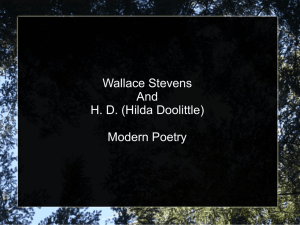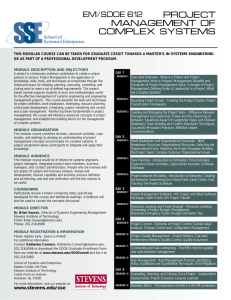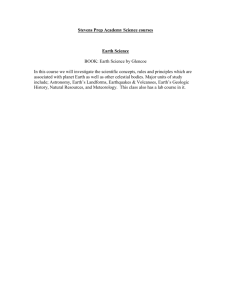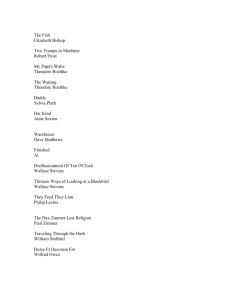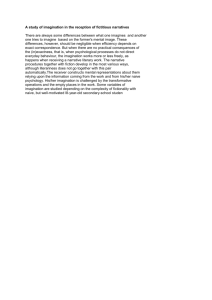The Song and the Sea: Imagination and Reality in Wallace Stevens's
advertisement
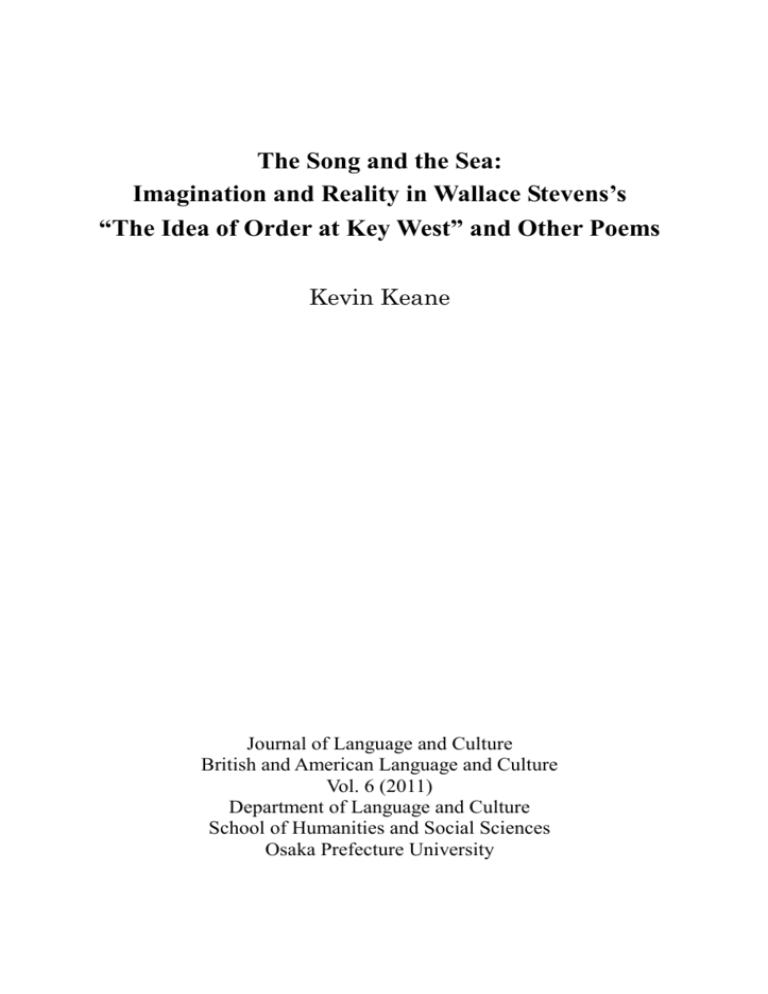
The Song and the Sea: Imagination and Reality in Wallace Stevens’s “The Idea of Order at Key West” and Other Poems Kevin Keane Journal of Language and Culture British and American Language and Culture Vol. 6 (2011) Department of Language and Culture School of Humanities and Social Sciences Osaka Prefecture University 59 Kevin Keane The Song and the Sea: Imagination and Reality in Wallace Stevens’s “The Idea of Order at Key West” and Other Poems Kevin Keane One of the important themes in Wallace Stevens’s poetry is the dialectic between imagination and reality. Stevens presents us in his works with groups of terms related to imagination and reality. In Stevens’s world imagination belongs to and dominates a category that includes the mind, art (especially poetry and music), heaven, religion, the sun, hope, and life itself. Reality has its own category including the earth, physical objects, machines, the moon, the animal (or “monster”) side of the self,1 and even death.2 In this paper I will examine Stevens’s poem “The Idea of Order in Key West,” with its theme about imagination and reality, as a paradigm for some other poems, namely, “The Man with the Blue Guitar,” “The Snow Man,” and “Thirteen Ways of Looking at a Blackbird.” Besides imagination and reality, these poems also focus on art, nature, and perception among other topics. As will be seen, imagination and reality in Stevens’s poetry can be interrelated and not just complete opposites. 1. The Relationship between Imagination and Reality This chapter concerns imagination and reality in Stevens’s “The Idea of Order at Key West” and “The Man with the Blue Guitar.” I will explain the difference between the two categories in these poems and suggest how they are connected to each other in Stevens’s view of life. 60 The Song and the Sea: Imagination and Reality in Wallace Stevens’s “The Idea of Order at Key West” and Other Poems In “The Idea of Order at Key West” Wallace Stevens speaks of a girl or woman singing at the shore. He says that “She sang beyond the genius of the sea” (Wallace Stevens: Selected Poems 77). Even though he means “spirit” by “genius,”3 he says that the sea’s song is “inhuman” (77). The girl and the sea are not “medleyed” (77). They are both singing or performing their songs independently. She is, in fact, singing a melody she learned “word by word” (72). It is possible one can hear in her phrases the “grinding water and the gasping wind” (77), but “It was she and not the sea that one heard” (77). The narrator, known as “we” (77-78), concentrates on listening to her sing. The girl is the “maker of the song we heard” (78). She is the song’s creator in the style that she is making on her own. She has a God-like presence at this moment. Indeed, the narrator even asks, “Whose spirit is this [. . .] because we knew / It was the spirit that we sought and knew / That we should ask this often as she sang” (78). Her singing then seems to awaken a desire of those listening for the spiritual. Her simple song is a mere song, but it could belong as well to the realm of the imagination in Stevens’s view if one found a divine aspect to it. As the poem progresses, the girl becomes something more than a mere singer and her song is also transformed. Stevens states that “She was the sole artificer of the world” (78). He makes a similar statement later: “That was her song for she was the maker” (78). She is not just the singer of the song. She makes the song in a sense by singing it. It belongs to her. Now she is the quasi-divine creator of her world. There is another interesting section in this poem where Stevens says: “[. . .] And when she sang, the sea, / Whatever self it had, became the self / That was her song, for she was the maker” (78). As an artificer, the girl seems to absorb the sea into herself, so to speak. She merges with the sea and becomes the dominant force. This theme of the artificer will appear again in “The Man with the Blue Guitar.” What Stevens is really saying Kevin Keane 61 here is that she is an artist who constructs her own world and does with it as she will. At any rate, in the final stanza of “The Idea of Order at Key West,” Stevens writes: Oh! Blessed rage for order, pale Ramon, The maker’s rage to order words of the sea [. . . .] (78) The woman in the poem has become more than the artist. She is a “maker” constructing her own reality. Stevens is referring to the human desire to find order in nature. The human imagination can make order out of apparent chaos. Stevens repeats the theme later in “The Man with the Blue Guitar”: “A tune beyond us as we are, / Yet nothing changed by the blue guitar” (54). He imagines “A million people on one string” (53). The guitar has become an instrument of art for all humanity. It transforms reality into something greater for everyone. Stevens, apparently speaking as the guitarist, even claims he can control a storm. He says: I know my lazy, leaden twang Is like the reason in a storm; And yet it brings the storm to bear. I twang it out and leave it there. (57) The guitar cannot fight a storm and yet the guitar—thanks to the power of art—seems to vanquish it or at least help us forget it for a while. Unlike “The Idea of Order at Key West,” the dichotomy between imagination/art and reality is found in a guitar played by a guitarist in “The Man with the Blue Guitar.” The man plays a role similar to that of the girl in “Key West,” but he transforms the guitar into an object greater than itself. The guitarist himself says, “Things as they / Are are changed upon the blue guitar” (52), but his audience says: 62 The Song and the Sea: Imagination and Reality in Wallace Stevens’s “The Idea of Order at Key West” and Other Poems But play, you must, A tune beyond us, yet ourselves, A tune upon the blue guitar Of things exactly as they are. (52) They prefer a realistic tune—that is, a conventional ditty—to an abstraction. Stevens also says the day is valuable. A candle at night helps illuminate everything. He asserts that the blue guitar and everything are in a kind of chiaroscuro, including “things as they are” (60). At night it is both light and dark, which he accepts. He apparently wants to tell us to accept both sides of life, imagination and reality, happiness and despair. Curiously enough, Stevens calls the mind or soul “an animal” (62) in stanza XVII. In stanza XVII he seems to be expressing the inner duality of humans. They have minds or souls, but they have an animal side, too. He seems to think of the animal side as the source of human passion, whereas the mind or soul is associated with the imagination. In stanza XIX Stevens talks about the monster side and “myself” (63) and wonders if they are one. He hopes to: […] reduce the monster and be Two things, the two together as one, And play of the monster and of myself [....] (63) He is trying here to resolve the balance between the artistic soul and its dark side through his art. Stevens also discusses how he wants to make poetry for non-religious “gods” (64). He conceives of poetry as being a lord high above the land and over men that is also a presence on earth: “The flesh, the bone, the dirt, the stone” (65). Stevens continues this theme about religion in stanza XXII. He speaks of a poem as being “like a missal found / In the mud” (66). He apparently Kevin Keane 63 conceives of a book of poetry as a potential Bible for his new religion. He writes: That scholar hungriest for that book, The very book, or, less, a page Or, at the least, a phrase, that phrase, A hawk of life, that latined phrase [….] (66-67) He views the desire for poetry as a joyful activity. Imagination and art bring meaning to life in Stevens’s world. Stanza XXVII reveals the occasional solipsistic tendency in Stevens’s thought. He says: And things are as I think they are And say they are on the blue guitar. (70) He lets the imagination triumph over reality. In the final stanza Stevens refers to two dreams: Here is the bread of time to come, Here is its actual stone. The bread Will be our bread, the stone will be Our bed and we shall sleep by night. We shall forget by day, except The moments when we choose to play The imagined pine, the imagined jay. (73-74) The two dreams are future possibilities; one dream is of hope and imagination (“bread”) and the other is of a hard reality (“stone”). We will forget our dreams and the power of our imagination except when we play the “imagined pine, the imagined jay” (73-74), apparently on the guitar. Perhaps he means here that the imagination will be neglected but 64 The Song and the Sea: Imagination and Reality in Wallace Stevens’s “The Idea of Order at Key West” and Other Poems sometimes we will recover traces of it and regain our ability to dream and imagine. Despite his focus on the imagination, Stevens also pays heed to reality throughout the poem. For example, Stevens refers to life and reality as “things as they are” (54). He states: And that’s life, then: things as they are, The buzzing of the blue guitar. (54) In stanza V Stevens refers to his notion of poetry as replacing religion and “heaven” (54). But then he suddenly becomes pessimistic. First he says, “Don’t speak to us of the greatness of poetry” (54). Then he sounds almost reductionist: “Day is desire and night is sleep [….] The earth, for us, is flat and bare” (54). However, at the end he hopes that poetry will fill up this emptiness despite his earlier pessimism. In VII he worries that one day the sun will abandon us: When shall I come to say of the sun, It is a sea; it shares nothing [….] (55) He is concerned here that the sun will become like the moon, which at present “shares nothing” (55). He is afraid that the earth will be “alive with creeping men, / Mechanical beetles never quite warm?” (55). This is an apocalyptic vision of a future where humans are reduced to machines or insects and workers are oppressed by a heartless society. The sun represents the imagination and all its positive attributes and the moon is cold, hard reality. He is worried that imagination, light, and goodness will desert us like the moon and make the world a miserable place to live. Concerning himself with death in stanza XXIII Stevens refers to “A few final solutions, like a duet / With the undertaker” (66). In addition, he speaks of a “voice in the clouds” (66) and “Another on earth” (66). He is referring to heaven and earth in this section. Heaven is the place of the imagination and possibilities; death is the final reality as found on earth, the place of limitations. He ends the stanza with these lines: “One keeps on Kevin Keane 65 playing year by year, / Concerning the nature of things as they are” (66). Stevens the guitarist can concern himself with the grim reality of the end of existence as well as the presence of possibilities in life. Stevens also proposes that we: Throw away the lights, the definitions, And say of what you see in the dark That it is this or that it is that, But do not use the rotted names. (72-73) He is in a realistic mood in these lines and thinking about how language can interfere with thinking clearly. He wants to find a new beginning in life for us through art (the “blue guitar”). He says, “You as you are? You are yourself. / The blue guitar surprises you” (73). In the end this approach seems more purifying than reductionist. Stevens seems to prefer the realm of the imagination and even makes a kind of new religion out of poetry. However, he does not abandon reality. He clearly acknowledges it in his writings. 2. Imagination, Reality, and Perception Some of Stevens’s poems treat how perception is a factor in the relationship between imagination and reality. I will analyze this role of perception in “Thirteen Ways of Looking at a Blackbird” and “The Snow Man.” The title of “Thirteen Ways of Looking at a Blackbird” is a reference to Hokusai’s series of woodblock prints of Mount Fuji and its surroundings, which give us multiple views of the scenery. Stevens’s poem likewise presents to us different ways to perceive one’s environment. As Susan Weston writes, the poem “dramatizes several moments when the imaginative mind is pierced by its relation to a particular reality” (21). The 66 The Song and the Sea: Imagination and Reality in Wallace Stevens’s “The Idea of Order at Key West” and Other Poems poem depicts a rather satori-like experience in which the perceiver gets a sudden sensation of new-found awareness. She explains that the blackbird “links the observer to what he sees” (Weston 21). Let us examine the passage below: Among twenty snowy mountains, The only moving thing Was the eye of the blackbird. (43) Weston says of this passage that: “The bird contrasts and thereby focuses the multiple large, black and static mountains against the single tiny, dark, and dynamic eye” (21). The perceiver can use his or her imagination to get a wider perspective of the world. Weston then goes on to comment on these lines: “The blackbird is involved / In what I know” (45). She says that the blackbird is the “perceiver’s sole means of knowing [….] The mind […] has an intimation of its limitations, realizing it suddenly is not the single center of perception but one among many” (22). The blackbird serves as a way to focus the mind on what it perceives, and it can open the mind to perceiving multiple perspectives. In “The Idea of Order at Key West,” there is a gap (that is later bridged) between the singer and the sea. Here the dichotomy is between the human mind and the blackbird that helps the mind perceive the world better than before. The final part of the poem is a reference to death. Stevens writes: It was evening all afternoon. It was snowing And it was going to snow. The blackbird sat In the cedar-limbs.4 (46) According to Weston, Stevens is showing in the last stanza above that “the infinite variety of stances the mind can take as it perceives reality is circumscribed by time and therefore death” (24). Death and reality limit us Kevin Keane 67 in the end. Our imagination has to deal with the finiteness of existence. In “The Snow Man” Stevens again talks about perception. Weston discusses how “difficult it is for the human perceiver to separate his perceptions from his thoughts” (9). The poem opens with this stanza: One must have a mind of winter To regard the frost and the boughs Of the pine-trees crusted with snow […] (10) This means that one must be indifferent to one’s own perceptions and surroundings. Of course, this is very difficult and perhaps no one can actually do it. The last stanza states: For the listener, who listens in the snow, And, nothing himself, beholds Nothing that is not there and the nothing that is. (15) In other words, one would have to be “nothing” to separate one’s thoughts from what one observes. Stevens is suggesting an extreme form of objectivity that would be a superhuman challenge for most of us. We have to accept that our thoughts, perceptions, and imagination have a subjective aspect binding us to this life. In both “Thirteen Ways of Looking at a Blackbird” and “The Snow Man” we can see the subjective nature of perception, but we are left in the former poem with the hope that we can gain awareness of the world around us. The imagination has to become aware of and deal with the facticity of life. 3. Conclusion In this essay I have explained how the paradigm of the song and the sea in “The Idea of Order at Key West” is echoed in “The Man with the Blue Guitar” and other poems written by Wallace Stevens. “Thirteen Ways of 68 The Song and the Sea: Imagination and Reality in Wallace Stevens’s “The Idea of Order at Key West” and Other Poems Looking at a Blackbird” presents us with the possibility of being able to have multiple viewpoints of the world that we perceive. As for “The Snow Man,” the poem describes how difficult it is to view objectively what we perceive; we would have to be mentally cold like a snowman. As for the paradigm of the sea and the song in “The Idea of Order at Key West,” the apparent dichotomy is between nature on the one hand and the human imagination — and the capacity to create art and in particular poetry — on the other hand. “The Man with the Blue Guitar” concerns the relationship between the guitar and the guitarist/Stevens. The guitar itself is just a piece of wood and metal — reality, as it were. The guitarist’s artistic imagination stands in contrast to the physical reality of the guitar.5 In the case of the “Thirteen Ways of Looking at a Blackbird,” there is a bond between the man6 with his initial narrow perceptions and the blackbird, who serves as his teacher showing him how he can have multiple viewpoints, instead of just one. He is learning how he can expand his sense of perception to fully appreciate his environment. The snowman matches the beauty of the snowy tableau around him with his supreme sense of objectivity. Wallace Stevens explains the importance of finding a balance between imagination and reality in this passage: “The imagination loses vitality as it chooses to adhere to what’s real. When it adheres to the unreal and intensifies what is unreal, while its first effect may be extraordinary, that effect is the maximum effect that it will ever have” (“The Necessary Angel” 6). In other words, imagination and reality exist in a kind of dialectic. They may seem like opposites, but, in fact, they are interdependent. One cannot have one without the other to survive in life. If one depends entirely on the imagination, what began as imagination would turn to wild fantasy. Likewise, concentrating exclusively on reality would make one’s view of life dull, prosaic, and one-sided.7 Kevin Keane 69 Notes 1. The “monster,” as treated in “The Man with the Blue Guitar,” is similar to the animal side of the self in the same poem, but it is a more negative version of it. 2. It is interesting to note that Simon Critchley examined the relationship between philosophical idealism and materialism (or realism) in Stevens’s works. Idealism would belong to the realm of the imagination and materialism would be part of the category of reality in Stevens’s universe. See Things Merely Are: Philosophy in the Poetry of Wallace Stevens (London: Routledge, 2008). 3. Eleanor Cook asserts that “genius” in this poem means the spirit of the place. For further analysis, see A Reader’s Guide to Wallace Stevens (Princeton: UP, 2007), 94. 4. This part is a variation on Basho’s haiku about a crow, which similarly employs a death image: On the dead limb squats a crow− autumn night. (On Love and Barley 35) 5. The guitarist also has to deal with the reality of his audience. He has his own artistic preferences, but his listeners want to hear the usual sort of music that they know. The guitarist—like the artist in general—has to find ways to accommodate his audience without completely compromising his artistic vision. 6. The man in the poem is sometimes the narrator and sometimes a character (“he”). This seems to be an approach similar to that in “The Man with the Blue Guitar.” Stevens seems to identify with the man and the latter’s need to broaden his perspective in life, so he speaks from his viewpoint at times. 70 The Song and the Sea: Imagination and Reality in Wallace Stevens’s “The Idea of Order at Key West” and Other Poems 7. The focus of this paper is on imagination and reality, but I should briefly mention that the other members of the categories to which imagination and reality belong probably have common points or some relationship with the members of the opposite category. For example, heaven rules over earth in most religions, and the moon appears at night after the sun sets. Likewise, death serves as the conclusion of life. Indeed, “life” in Stevens’s poetry is existence, as opposed to death, but it can additionally mean reality. Life in the sense of reality limits the imagination, hope, and existence itself. Works Cited Cook, Eleanor. A Reader’s Guide to Wallace Stevens. Princeton: UP, 2007. Critchley, Simon. Things Merely Are: Philosophy in the Poetry of Wallace Stevens. London: Routledge, 2005. Matsuo, Basho. On Love and Barley: Haiku of Basho. Lucien Stryk, trans. London: Penguin, 1985. ______. “On the Dead Limb...” On Love and Barley: 35. Stevens, Wallace. Wallace Stevens: Selected Poems. London: Faber and Faber 1978. ______. The Necessary Angel: Essays on Reality and the Imagination. New York: Vintage, 1951. Weston, Susan. Wallace Stevens: An Introduction to the Poetry. New York: Columbia UP, 1977.

